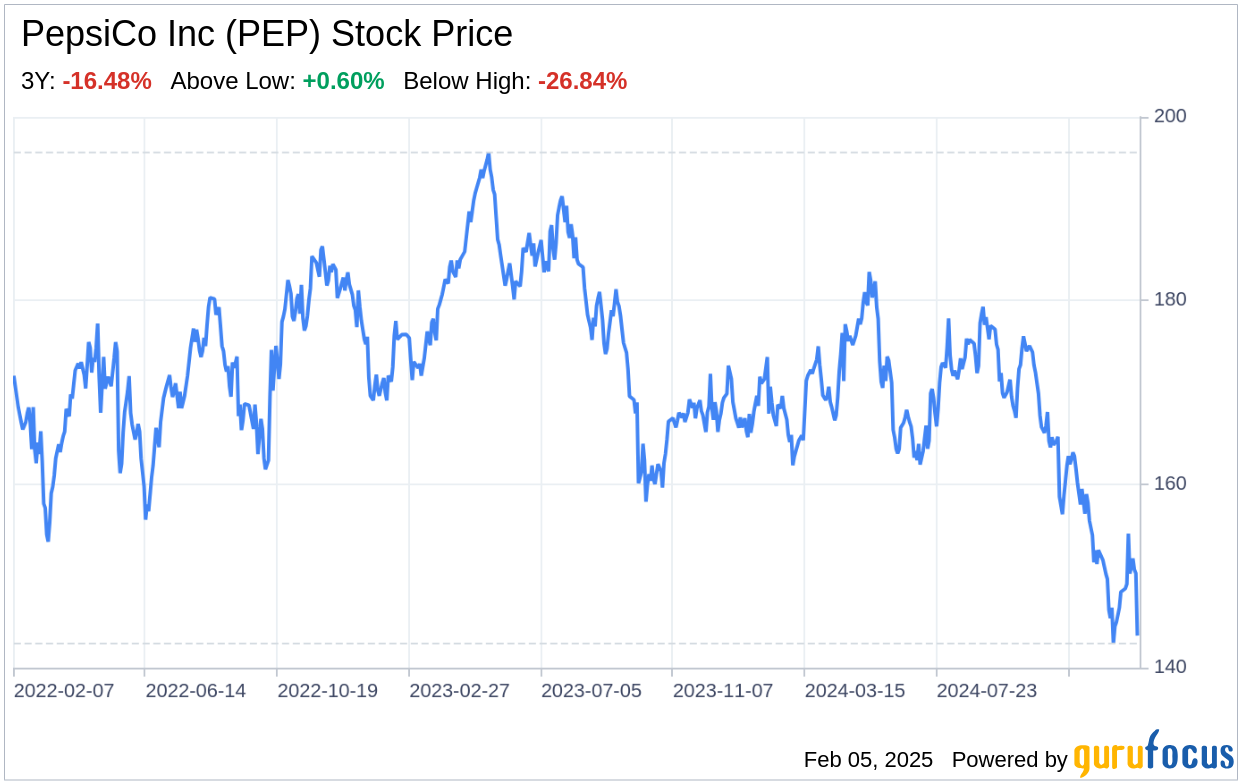On February 4, 2025, PepsiCo Inc (PEP, Financial), a global leader in snacks and beverages, filed its 10-K report with the SEC, offering a detailed look at its financial performance and strategic positioning. With a market capitalization of $224.8 billion as of mid-2024 and a diverse portfolio of brands, PepsiCo continues to be a dominant force in the industry. The company's financials reveal a robust revenue stream, with convenience foods accounting for 55% of total revenue and beverages making up the remainder. International markets contribute significantly to sales, with 40% of total sales and one-third of operating profits originating from overseas. This financial overview sets the stage for a deeper SWOT analysis, providing investors with a clearer understanding of PepsiCo's strengths, weaknesses, opportunities, and threats.

Strengths
Brand Portfolio and Market Leadership: PepsiCo's brand portfolio is one of its most formidable strengths. With household names like Pepsi, Mountain Dew, Gatorade, Lay's, Cheetos, and Doritos, the company has established a loyal customer base and significant brand equity. PepsiCo's brands not only enjoy high consumer recognition but also hold leadership positions in their respective categories. For instance, in 2024, PepsiCo and its primary competitor, The Coca-Cola Company, held approximately 18% and 21% of the U.S. liquid refreshment beverage category by estimated retail sales in measured channels. PepsiCo's brand power is a testament to its effective marketing, innovation, and distribution strategies, which have enabled it to maintain a competitive edge in a crowded marketplace.
Global Reach and Diversification: PepsiCo's global presence is another strength, with operations serving customers in over 200 countries and territories. The company's international sales make up a significant portion of its total revenue, demonstrating its ability to navigate diverse markets and consumer preferences. This geographical diversification not only mitigates risks associated with any single market but also provides multiple avenues for growth. Moreover, PepsiCo's product diversification across snacks and beverages allows it to cater to a wide range of consumer needs, further solidifying its market position.
Weaknesses
Dependence on Key Customers: PepsiCo's reliance on major customers like Walmart Inc., which accounted for approximately 14% of its consolidated net revenue in 2024, poses a potential weakness. The loss of such a significant customer could materially impact divisions like FLNA, QFNA, and PBNA. This dependence on a few large customers could lead to vulnerability in the event of contract losses or changes in purchasing patterns, necessitating a strategic focus on diversifying customer relationships and reducing concentration risk.
Competition and Market Saturation: The highly competitive nature of the beverage and convenient food industry is a weakness that requires constant innovation and marketing efforts from PepsiCo. With competitors ranging from international companies to regional and local manufacturers, PepsiCo must continuously invest in product development, advertising, and promotional activities to maintain its market share. The company's ability to respond to consumer trends, such as the demand for healthier options and sustainable packaging, is crucial to staying relevant and avoiding market saturation.
Opportunities
Health and Wellness Trends: The growing consumer focus on health and wellness presents a significant opportunity for PepsiCo. By continuing to reformulate existing products to reduce sodium, saturated fat, and added sugars, and by expanding its portfolio to include more functional ingredients and positive nutrition, PepsiCo can capitalize on this trend. The company's research and development efforts aimed at creating consumer-preferred products and packaging innovations can help it meet evolving consumer demands and drive growth.
E-commerce and Digital Expansion: The acceleration of e-commerce and digital channels offers a substantial opportunity for PepsiCo to enhance its direct-to-consumer capabilities. By strengthening its omnichannel presence and leveraging artificial intelligence and data analytics, PepsiCo can improve consumer insights, personalize offerings, and optimize its supply chain. This digital transformation can lead to increased sales through online platforms and mobile commerce applications, providing a competitive advantage in a rapidly changing retail landscape.
Threats
Geopolitical Events and Consumer Preferences: Geopolitical events, pandemics, and shifts in consumer preferences pose significant threats to PepsiCo's operations. The ongoing conflicts in regions like Ukraine and the Middle East, along with potential disease outbreaks, can disrupt supply chains and affect consumer demand for PepsiCo's products. Additionally, negative consumer sentiment toward non-local products and potential public boycotts can impact sales. PepsiCo must remain agile and responsive to these external factors to mitigate their potential adverse effects on the business.
Environmental Concerns and Regulatory Pressures: Water scarcity and environmental concerns are growing threats that can impact PepsiCo's manufacturing processes and raw material production. Actions by governmental and non-governmental organizations on water conservation and the increasing pressure to develop sustainable packaging solutions can lead to higher compliance costs and capital expenditures. Regulatory changes and consumer expectations regarding environmental responsibility require PepsiCo to continuously invest in technologies and practices that reduce its environmental footprint.
In conclusion, PepsiCo Inc (PEP, Financial) exhibits a strong market presence with its diverse brand portfolio and global reach, which are key strengths in the competitive snacks and beverages industry. However, the company must address weaknesses such as its reliance on key customers and the need for continuous innovation to combat market saturation. Opportunities for growth lie in the health and wellness trend and the expansion of e
This article, generated by GuruFocus, is designed to provide general insights and is not tailored financial advice. Our commentary is rooted in historical data and analyst projections, utilizing an impartial methodology, and is not intended to serve as specific investment guidance. It does not formulate a recommendation to purchase or divest any stock and does not consider individual investment objectives or financial circumstances. Our objective is to deliver long-term, fundamental data-driven analysis. Be aware that our analysis might not incorporate the most recent, price-sensitive company announcements or qualitative information. GuruFocus holds no position in the stocks mentioned herein.
